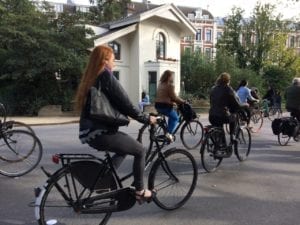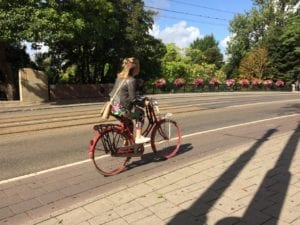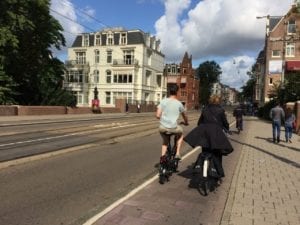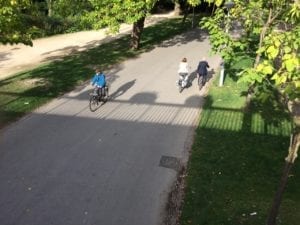Bicycle culture in Amsterdam is impressive
We’ve spent a few weeks now at our new home in Stratford, population 32,000.
Here’s an interesting thing I have noted, in the course of three months of travels across Southern Ontario, as well as in Europe, before we bought our new house (that is, an old house well over 100 years old).
As a person who has lived in big cities most of my life, I’ve noted that I have tended, when outside of the big city environment, to look at things with characteristic “big-city eyes.”
I’ve quickly learned – in what I would describe as a self-aware way – to put that perspective aside, and look at what I see as a person seeing a place for the first time. That makes for an easy transition – and a great ongoing learning experience – going from one environment to another.
Estonia as part of Scandinavia
From our travels in Europe, before we purchased a house in Stratford, many good memories stay with us. Among the things I remember the most was the sense of Estonia being part of Scandinavia. I spoke with people about this concept at length. I found the topic of much interest.
I also much enjoyed meeting old and new friends in Tallinn. Some friends I had not seen for close to thirty years. That in itself was quite an experience – most illuminating and valuable, to reconnect after such a passage of years.
This was somewhat different than meeting some high school classmate in Canada from the 1960s that I had not seen in fifty-plus years. If we had not worked on common projects in our high school years, there was not necessarily the same sense of intensive learning, as a result of such meetings, in recent years. There wasn’t the same basis for the same extent of “before” and “after” comparisons and reflections.
In the case of the friendships in Estonia, that I refer to, the people I had not met in thirty years were people that I had worked with on collaborative projects. We had gotten to know each other in that context.
Meeting each other, and comparing notes, was a mutually enjoyable and I would say an enlightening and highly informative experience. I thought about things that had remained the same and things that were now different – in particular with regard to the improved environment that was evident, since the time that Estonia had regained its independence in 1991.
As well, we enjoyed the Old Towns in both Tallinn and Stockholm. It’s wonderful to spend time among repurposed buildings dating back to medieval times.
As well, in Estonia I visited people at their homes. I enjoyed that. Among the homes I visited was a house in part of what’s called (I’m translating this from the Estonian) a “Swedish villa” – or perhaps the translation is “Swedish village.” The Estonian term is “Rootsi küla.”
This was a small residential development in Tallinn, where houses are clustered together in small-scale groupings in such a way that neighbours (including children) get to know each other well, and in many cases do things together.
The sense of totally private space by way of front yards is blurred, in such a setting, meaning that neighbours can walk across front yards everywhere. The concept has been imported from Sweden. There was also a common area where kids could play sports and hang out. I very much liked that arrangement – a sense of people being together, enjoying each other’s company in shared outdoor spaces, while also enjoying the privacy associated with each family’s indoor spaces.
A key point about such arrangements is that they are voluntary. Families choose to buy a house in such a “villa” if they are so inclined. I heard, from a family I visited at the “Swedish villa,” of one case where a family had moved out, to live in a bigger house in other part of Tallinn with a clearly defined front yard that operated as a strictly private space. There was clearly a sense of a trade-off, in this case. There was more privacy but that sense of conviviality, of sharing something important at the level of everyday social interactions, was now missing.
I also visited a village on the Baltic coast where a similar arrangement – that is, with regard to a common area where kids can play sports and hang out – has been in place for many, many decades. Again, I very much like such arrangements.
We have such arrangements, as a result of happenstance and occasionally by design, in neighbourhoods across Canada, as well, of course. It’s wonderful, when people can be neighbourly and enjoy each other’s company.
Analog existence
When we were in Europe, I found I needed to focus on essentials, such as making sure I had my boarding pass and other details all in place, as we travelled place to place. It was during this time that I decided that I would spend time online, visiting news websites, only a few times a month rather than several times a day.
That was really great – to leave the news aside for a while. When I visited a news website, or read a newspaper, after omitting such practices for weeks at a time, I found I caught up quickly; I hadn’t missed much at all.
I much prefer to keep my head clear, and focused on matters in my immediate, physical environment – on matters where I can make a difference, one way or another.
As well, for many news-related topics, I prefer to read library books.
Mindfulness
At times we were dealing, during our travels, with official documents and deadlines related to buying a house. That can be stressful at times. I found that it was a great idea, in this context, to engage in the formal practice of mindfulness meditation, twenty minutes a day. I’ve been practicing mindfulness – including sitting meditation – off and on for many years. I now have a renewed interest in the formal practice of mindfulness meditation.
Application of mindfulness, from moment to moment in everyday life – I’ve been practising that for many years, with good results, but that is separate from formal meditation.
I’ve also noted, in looking at magazine racks in the course of my travels in Ontario, that many lifestyle magazines are available, that extol the benefits of mindfulness meditation.
At times, I feel less than at ease when I encounter the thought that mindfulness is being pitched as a way that people can handle the drawbacks of neoliberalism. On the other hand, I would say that the practical benefits, of mindfulness as a way to deal with stress and get more enjoyment from life, are indeed worth publicizing.
Nordic mythology
I much enjoyed a flight delay, on the way back from Amsterdam to Toronto. I spent a lot of time at bookshops at the Amsterdam airport, buying several good books. Among them was a paperback about Nordic mythology, which I much enjoyed.
I also bought several paperbacks dealing with cultural differences, as well as books dealing with how we as human beings make sense of everyday reality.
Books dealing with our perceptions of reality have long interested me. I was pleased to see that many travellers must have similar interests.
Bicycle culture in Amsterdam
The bicycle culture in Amsterdam also had a strong impact on me. The sight of people riding abreast on their bikes, carrying on an extended conversation kilometre and kilometre – those are among the great things that have stayed with me.
I also much enjoyed seeing young children sitting side by side, carrying on conversations while sitting in purpose-built carts, attached to bicycles, propelled by their parents.
What I saw in Amsterdam was most inspiring for me. The city’s approach to bicycling underlines, for me, what people are capable of achieving when the desire, know-how, and requisite political energies are in place. It feels great just to picture what I saw, in the time we were in Amsterdam.
The unofficial Banksy exhibition that we visited in Amsterdam in August 2018 also stays in mind. After the visit, I checked out many resources, at the Toronto Public Library website having to do with the “street art movement.” It occurred to me that street art imagery, of the kind popularized by Banksy, can be used to promote any kind of political system imaginable. That’s because any image exists within a conceptual framework, which gives the image its meaning.
That fact prompted me to start reading about totalitarian art, and about totalitarianism in general. That reading has been a major focus for me in the past month or so. Currently among the books I’m reading is a great 1952 non-fiction text by Aldous Huxley.
Updates
A June 11, 2018 Atlantic article is entitled: “‘Cargo-Bike Moms’ Are Gentrifying the Netherlands: In Rotterdam, the bakfiets utility bike has become a symbol – and a tool – of urban displacement.”
An Aug. 19, 2019 BBC article is entitled: “What’s it like to live in an over-touristed city? Locals explain how the influx of travellers has affected them, how authorities are responding and how visitors can remain respectful of people who live there year-round.”
An Oct. 1, 2019 BBC article is entitled: “Banksy shop featuring Stormzy stab vest appears in Croydon: Elusive artist Banksy has set up a shop in south London featuring the stab vest he designed for Stormzy’s headline act at the Glastonbury Festival.”
An Oct. 2, 2019 CBC article is entitled: “Banksy canvas of chimps in U.K. Parliament up for auction amid Brexit: Sotheby’s hoping for record price of up to $3.3M Cdn.”
Power of a vision
A subsequent post is entitled:





Leave a Reply
Want to join the discussion?Feel free to contribute!